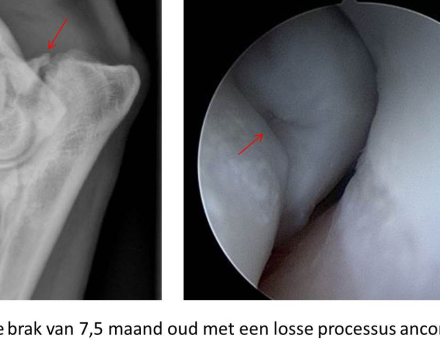- HOME EN
- Vet
- Owner
- VECRA
- Appointment
- Our team
- Contact
- News
- Home
- Owner
- Small pets
- Orthopedics
- Arthroscopies
- Elbow
- LAP - loose anconeal process
LAP or loose anconeal process
A loose anconeal process (LAP) is one of the developmental problems that belongs to the group of elbow dysplasia.
The German Shepherd is widely known as a breed that is highly susceptible to loose anconeal process. However, new research into predisposition to LAP has shown that Labradors and Golden Retrievers are just as likely, if not more likely, to develop LAP.
Although the exact cause of this condition remains unclear, a multifactorial cause has been suggested: trauma, metabolic and genetic abnormalities may all play a role in the development of a loose anconeal process.
Affected dogs are often presented at an age between 2 and 9 months with complaints of lameness in one or both front legs. Clinical examination may reveal a painful, swollen elbow. Crepitus is also often present when bending and stretching the affected elbows. Pain and/or osteoarthritis may cause reduced flexibility. In some cases, it is even possible to feel and move the loose fragment.
This condition can usually be diagnosed on the basis of X-rays. Arthroscopy provides more information about the severity of the injury and the resulting damage to the elbow joint.
Photo 1 - A 1.3-year-old German Shepherd with a loose anconeal process (see arrow). Left: image from the CT scan. Right: arthroscopy.
Photo 2 - A 7.5-month-old Italian Hound with a loose anconeal process (see arrow).
Orsami
Universiteit Gent - Faculteit Diergeneeskunde
Salisburylaan 1339820 Merelbeke (Oost-Vlaanderen)België
info.khd@ugent.be+32 9 264 77 00 (kleine huisdieren)+32 9 264 76 18 (grote huisdieren)
Opening hours
| Mo: | 8 - 12h | 12 - 16h |
| Tu: | 8 - 12h | 12 - 16h |
| We: | 8 - 12h | 12 - 16h |
| Th: | 8 - 12h | 12 - 16h |
| Fr: | 8 - 12h | 12 - 16h |
| Sa: | Closed | Closed |
| Su: | Closed | Closed |


